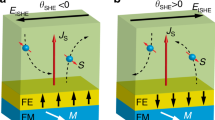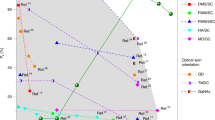Abstract
Electrical detection of spin-polarized transport in semiconductors is one of the key prerequisites for successful incorporation of spin in semiconductor microelectronics. The present schemes are based on spin-dependent transport effects within the spin generation region in the semiconductor, or on non-local detection outside the spin-injection area using a ferromagnet attached to the semiconductor. Here, we report that polarized injection of carriers can be detected by transverse electrical signals directly along the semiconducting channel, both inside and outside the injection area, without disturbing the spin-polarized current or using magnetic elements. Our planar p–n diode microdevices enable us to demonstrate Hall effect symmetries and large magnitudes of the measured effect. Supported by microscopic calculations, we infer that the observed spin-injection Hall effect reflects spin dynamics induced by an internal spin–orbit field and is closely related to the anomalous and spin Hall effects. The spin-injection Hall effect is observed up to high temperatures and our devices represent a realization of a non-magnetic spin-photovoltaic polarimeter that directly converts polarization of light into transverse voltage signals.
This is a preview of subscription content, access via your institution
Access options
Subscribe to this journal
Receive 12 print issues and online access
$209.00 per year
only $17.42 per issue
Buy this article
- Purchase on Springer Link
- Instant access to full article PDF
Prices may be subject to local taxes which are calculated during checkout





Similar content being viewed by others
References
Kikkawa, J. M. & Awschalom, D. D. Lateral drag of spin coherence in gallium arsenide. Nature 397, 139–141 (1999).
Kato, Y. K., Myers, R. C., Gossard, A. C. & Awschalom, D. D. Observation of the spin Hall effect in semiconductors. Science 306, 1910–1913 (2004).
Crooker, S. A. et al. Imaging spin transport in lateral ferromagnet/semiconductor structures. Science 309, 2191–2195 (2005).
Weber, C. P. et al. Non-diffusive spin dynamics in a two-dimensional electron gas. Phys. Rev. Lett. 98, 076604 (2007).
Lou, X. et al. Electrical detection of spin transport in lateral ferromagnet-semiconductor devices. Nature Phys. 3, 197–202 (2007).
Fiederling, R. et al. Injection and detection of a spin-polarized current in a light-emitting diode. Nature 402, 787–790 (1999).
Ohno, Y. et al. Electrical spin injection in a ferromagnetic semiconductor heterostructure. Nature 402, 790–792 (1999).
Zhu, H. J. et al. Room-temperature spin injection from Fe into GaAs. Phys. Rev. Lett. 87, 016601 (2001).
Jiang, X. et al. Highly spin-polarized room-temperature tunnel injector for semiconductor spintronics using MgO(100). Phys. Rev. Lett. 94, 056601 (2005).
Wunderlich, J., Kaestner, B., Sinova, J. & Jungwirth, T. Experimental observation of the spin-Hall effect in a two dimensional spin–orbit coupled semiconductor system. Phys. Rev. Lett. 94, 047204 (2005).
Chazalviel, J. N. Spin-dependent Hall effect in semiconductors. Phys. Rev. B 11, 3918–3934 (1975).
Ohno, H., Munekata, H., Penney, T., von Molnár, S. & Chang, L. L. Magnetotransport properties of p-type (In,Mn)As diluted magnetic III–V semiconductors. Phys. Rev. Lett. 68, 2664–2667 (1992).
Cumings, J. et al. Tunable anomalous Hall effect in a nonferromagnetic system. Phys. Rev. Lett. 96, 196404 (2006).
Miah, M. I. Observation of the anomalous Hall effect in GaAs. J. Phys. D: Appl. Phys. 40, 1659–1663 (2007).
Ganichev, S. D. et al. Conversion of spin into directed electric current in quantum wells. Phys. Rev. Lett. 86, 4358–4361 (2001).
Hammar, P. R. & Johnson, M. Detection of spin-polarized electrons injected into a two-dimensional electron gas. Phys. Rev. Lett. 88, 066806 (2002).
Valenzuela, S. O. & Tinkham, M. Direct electronic measurement of the spin Hall effect. Nature 442, 176–179 (2006).
Huang, B., Monsma, D. J. & Appelbaum, I. Coherent spin transport through a 350 micron thick silicon wafer. Phys. Rev. Lett. 99, 177209 (2007).
Wunderlich, J. et al. Influence of geometry on domain wall propagation in a mesoscopic wire. IEEE Trans. Mag. 37, 2104–2107 (2001).
Yamanouchi, M., Chiba, D., Matsukura, F. & Ohno, H. Current-induced domain-wall switching in a ferromagnetic semiconductor structure. Nature 428, 539–542 (2004).
Nomura, K. et al. Edge spin accumulation in semiconductor two-dimensional hole gases. Phys. Rev. B 72, 245330 (2005).
Kaestner, B., Hasko, D. G. & Williams, D. A. Design of quasi-lateral p–n junction for optical spin-detection in low-dimensional systems. Preprint at <http://arxiv.org/abs/cond-mat/0411130> (2004).
Žutić, I., Fabian, J. & Sarma, S. D. Spin-polarized transport in inhomogeneous magnetic semiconductors: Theory of magnetic/nonmagnetic p–n junctions. Phys. Rev. Lett. 88, 066603 (2002).
Kondo, T., Hayafuji, J. & Munekata, H. Investigation of spin voltaic effect in a pn heterojunction. Jpn. J. Appl. Phys. 45, L663–L665 (2006).
Knap, W. et al. Weak antilocalization and spin precession in quantum wells. Phys. Rev. B 53, 3912–3924 (1996).
Winkler, R. Spin–Orbit Coupling Effects in Two-Dimensional Electron and Hole Systems (Springer, 2003).
Schliemann, J., Egues, J. C. & Loss, D. Nonballistic spin-field-effect transistor. Phys. Rev. Lett. 90, 146801 (2003).
Bernevig, B. A., Orenstein, J. & Zhang, S.-C. An exact SU(2) symmetry and persistent spin helix in a spin–orbit coupled system. Phys. Rev. Lett. 97, 236601 (2006).
Nozieres, P. & Lewiner, C. A simple theory of the anomalous Hall effect in semiconductors. J. Phys. France 34, 901–915 (1973).
Crépieux, A. & Bruno, P. Theory of the anomalous Hall effect from the Kubo formula and the Dirac equation. Phys. Rev. B 64, 014416 (2001).
Borunda, M. et al. Absence of skew scattering in two-dimensional systems: Testing the origins of the anomalous Hall effect. Phys. Rev. Lett. 99, 066604 (2007).
Datta, S. & Das, B. Electronic analog of the electro-optic modulator. Appl. Phys. Lett. 56, 665–667 (1990).
Žutić, I., Fabian, J. & Das Sarma, S. Spintronics: Fundamentals and applications. Rev. Mod. Phys. 76, 323–410 (2004).
Žutić, I., Fabian, J. & Erwin, S. C. Spin injection and detection in silicon. Phys. Rev. Lett. 97, 026602 (2006).
Acknowledgements
We thank E. Rozkotová, Z. Výborný, V. Jurka and K. Hruška for experimental assistance, M. Borunda, A. Kovalev and S.-C. Zhang for fruitful discussions and acknowledge support from EU Grant FP7-215368 SemiSpinNet, from Czech Republic Grants FON/06/E001, FON/06/E002, AV0Z10100521, KAN400100652, LC510, and Preamium Academiae, and from US Grants ONR-N000140610122, DMR-0547875 and SWAN-NRI. J.S. is a Cottrell Scholar of Research Corporation.
Author information
Authors and Affiliations
Contributions
Device fabrications: A.C.I., J.W., V.N., B.K.; experiments and data analysis: J.W., B.G.P, X.L.X., T.J., J.S.; theory: J.S., L.P.Z., T.J., J.W.; writing: T.J., J.S., J.W.; project planning: J.W., A.C.I., T.J., J.S.
Corresponding author
Supplementary information
Supplementary Information
Supplementary Information (PDF 736 kb)
Rights and permissions
About this article
Cite this article
Wunderlich, J., Irvine, A., Sinova, J. et al. Spin-injection Hall effect in a planar photovoltaic cell. Nature Phys 5, 675–681 (2009). https://doi.org/10.1038/nphys1359
Received:
Accepted:
Published:
Issue Date:
DOI: https://doi.org/10.1038/nphys1359
This article is cited by
-
Spin Precession and Spin‐Charge Conversion in a Strong Rashba Channel at Room Temperature
Electronic Materials Letters (2021)
-
Far out-of-equilibrium spin populations trigger giant spin injection into atomically thin MoS2
Nature Physics (2019)
-
Photo-induced Hall effect in metals
Scientific Reports (2018)
-
Spin–torque generator engineered by natural oxidation of Cu
Nature Communications (2016)
-
Long-range and high-speed electronic spin-transport at a GaAs/AlGaAs semiconductor interface
Scientific Reports (2016)



